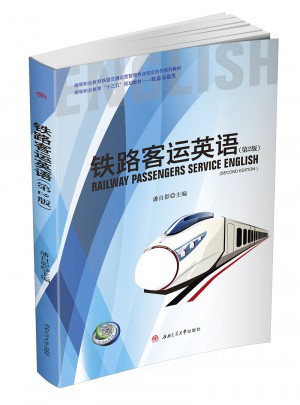
鐵路客運英語(第2版)
- 所屬分類:圖書 >工業(yè)技術(shù)>汽車與交通運輸>鐵路運輸 圖書 >教材>研究生/本科/專科教材>工學(xué)
- 作者:[潘自影]
- 產(chǎn)品參數(shù):
- 叢書名:高等職業(yè)教育“十三五”規(guī)劃教材---軌道交通類
- 國際刊號:9787564349059
- 出版社:西南交通大學(xué)出版社
- 出版時間:2016-08
- 印刷時間:2016-08-01
- 版次:2
- 開本:16開
- 頁數(shù):214
- 紙張:膠版紙
- 包裝:平裝-膠訂
- 套裝:否

本書是高職鐵路英語教材,是《鐵路客運英語》第2版。本書以培養(yǎng)學(xué)生的客運服務(wù)能力為本,打破傳統(tǒng)教材編寫模式,結(jié)合一線工作實踐,以客運服務(wù)崗位工作項目為基礎(chǔ)來組織編寫內(nèi)容。主要包括車站服務(wù)工作、乘車服務(wù)工作以及觀光旅游服務(wù)三個項目。每個項目都包含教學(xué)目標(biāo)、典型對話、有用的表達以及有關(guān)鐵路介紹的課文。本書融入全新的教育理念和科學(xué)的教學(xué)方法,具有實用性、系統(tǒng)性以及時代性,為鐵路高職學(xué)生與鐵路工人培訓(xùn)的教材。
潘自影,天津鐵道職業(yè)技術(shù)學(xué)院鐵道運輸系教師,從事鐵道交通運營管理專業(yè)和高鐵乘務(wù)專業(yè)的相關(guān)教學(xué)工作,近年來,主要從事鐵路客運英語、鐵路客運服務(wù)與禮儀、公共關(guān)系等課程教學(xué)的教學(xué)工作,專業(yè)基礎(chǔ)深厚,有一定影響力。在《繼續(xù)教育研究》《中國科教創(chuàng)新導(dǎo)刊》等雜志上發(fā)表多篇論文。已經(jīng)出版任主編的教材《鐵路客運英語》。
Contents
Project 1 Station Service 1
Task 1 At Inquiry Office 2
Task 2 At Ticket Office 12
Task 3 At the Luggage Office 24
Task 4 In the Waiting Room 33
Task 5 At the Ticket Entrance 44
Task 6 On the Platform 53
Task 7 At the Entry-exit Joint Inspection Hall 62
Task 8 Station Broadcasting 71
Project 2 Train Service Work 79
Task 1 Welcoming Passengers Aboard 80
Task 2 Showing Passengers to Their Places 87
Task 3 Service in the Car 96
Task 4 The Dinner Car Service 109
Task 5 Pre-arrival Jobs 121
Task 6 Special and Emergency Service 130
Task 7 Complaints, Thanks, Apologies and Advice 141
Project 3 Tourism Service 151
Task 1 Customs and Culture 152
Task 2 Natural Scenery 163
Task 3 Historical Places 173
The Translation of the texts 183
Project 1 183
Task 1 183
Task 2 183
Task 3 184
Task 4 184
Task 5 185
Task 6 185
Task 7 186
Task 8 186
Project 2 187
Task 1 187
Task 2 188
Task 3 188
Task 4 189
Task 5 190
Task 6 190
Task 7 191
Project 3 191
Task 1 191
Task 2 192
Task 3 192
Appendixes 193
Appendix?Ⅰ Railway Passenger Service Vocabulary 193
Appendix?Ⅱ Common Public Signs 203
Appendix?Ⅲ Chinese Food and Western Food 206
Appendix?Ⅳ Scenic Spots and Historical Sites in China 210
參考文獻 214
目 錄
項目一 車站服務(wù) 1
典型工作任務(wù)一 在問訊處 2
典型工作任務(wù)二 在售票處 12
典型工作任務(wù)三 在行李處 24
典型工作任務(wù)四 在候車室 33
典型工作任務(wù)五 在檢票口 44
典型工作任務(wù)六 在站臺 53
典型工作任務(wù)七 在出入境聯(lián)檢大廳 62
典型工作任務(wù)八 車站廣播 71
項目二 列車服務(wù)工作 79
典型工作任務(wù)一 歡迎乘車 80
典型工作任務(wù)二 領(lǐng)鋪、領(lǐng)座 87
典型工作任務(wù)三 車廂服務(wù) 96
典型工作任務(wù)四 餐車服務(wù) 109
典型工作任務(wù)五 到站前服務(wù) 121
典型工作任務(wù)六 特殊及應(yīng)急服務(wù) 130
典型工作任務(wù)七 投訴、感謝、道歉及建議 141
項目三 旅游服務(wù) 151
典型工作任務(wù)一 風(fēng)俗文化 152
典型工作任務(wù)二 自然風(fēng)光 163
典型工作任務(wù)三 歷史遺跡 173
課文翻譯 183
項目一 183
典型工作任務(wù)一 183
典型工作任務(wù)二 183
典型工作任務(wù)三 184
典型工作任務(wù)四 184
典型工作任務(wù)五 185
典型工作任務(wù)六 185
典型工作任務(wù)七 186
典型工作任務(wù)八 186
項目二 187
典型工作任務(wù)一 187
典型工作任務(wù)二 188
典型工作任務(wù)三 188
典型工作任務(wù)四 189
典型工作任務(wù)五 190
典型工作任務(wù)六 190
典型工作任務(wù)七 191
項目三 191
典型工作任務(wù)一 191
典型工作任務(wù)二 192
典型工作任務(wù)三 192
附 錄 193
附錄1 鐵路客運服務(wù)常用詞匯 193
附錄2 常見公共標(biāo)志 203
附錄3 中餐和西餐 206
附錄4 中國各地名勝古跡 210
參考文獻 214
典型工作任務(wù)一 在問訊處
Teaching Objectives 教學(xué)目標(biāo)
1. Ability Objective 能力目標(biāo)
(1) Be able to help passengers buy train tickets or platform tickets.
(2) Be able to help passengers buy one’s train ticket after normal time.
(3) Be able to tell passengers how to book train tickets in advance.
(4) Be able to read and comprehend short English passage about buying train ticket.
(1) 能夠幫助旅客買火車票和站臺票。
(2) 能夠幫助旅客補票。
(3) 能夠告訴旅客怎樣預(yù)定火車票。
(4) 能夠閱讀并理解關(guān)于購買火車票的英文短文。
2. Knowledge Objective 知識目標(biāo)
(1) Master the useful expressions about changing trains.
(2) Memorize new words and phrases in the short passage.
(3) Know the means of buying train tickets.
(1) 掌握關(guān)于換乘車次的常用表達。
(2) 記憶短文中的單詞和短語。
(3) 熟悉購買火車票的方法。
3. Quality Objective 素質(zhì)目標(biāo)
The clerk should answer and explain passengers’ questions politely, and should keep patient. The clerk should be familiar with railway rules and regulations and should make efforts to study them.
客運員應(yīng)禮貌和耐心地回答和解釋旅客的問題。客運員要熟悉并努力學(xué)習(xí)鐵路規(guī)章制度。
Part Ⅰ Dialogues 對話
Dialogue One
P: Excuse me, is this the Inquiry Office?
C: Yes, it is. What can I do for you?
P: My mother takes heavy luggage. I want to give her a hand and help her arrange the luggage. What should I do?
C: You can buy a platform ticket and see her off by yourself or you can ask someone for help.
P: Who can help me?
C: Staff members for passenger service. He or she will help your mother to get on the train.
P: Thank you for your advice. I decide to buy a platform ticket. How much shall I pay for the platform ticket?
C: One yuan.
P: Thank you very much.
C: It’s my pleasure.
P: 打擾了,這是問訊處嗎?
C: 是的。有什么我可以為您效勞嗎?
P: 我母親帶的行李很重,我想幫她把行李安置好。我該怎么做呢?
C: 您可以購買一張站臺票親自送她或者您也可以讓別人幫忙。
P: 誰能幫我呢?
C: 客服員工。他或她會幫您母親上車。
P: 謝謝您的建議。我決定購買站臺票,站臺票多少錢?
C: 1元。
P: 非常感謝。
C: 不用客氣。
P=passenger旅客,C=clerk客運員,TS=ticket seller售票員,S=student學(xué)生,SA=station attendant車站服務(wù)員,B=baggageman行李員,A=attendant服務(wù)員,D=doctor醫(yī)生,Pm=policeman警察
正版 不錯
還可以,只是書沒有看完